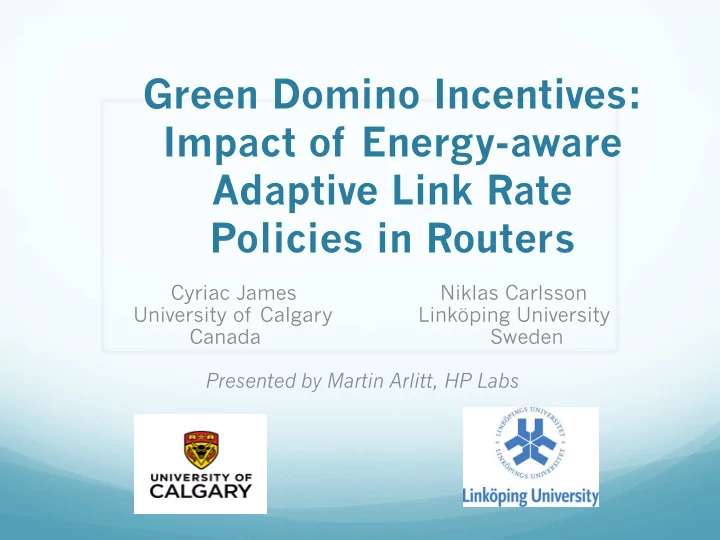

Green Domino Incentives: Impact of Energy-aware Adaptive Link Rate Policies in Routers Cyriac James Niklas Carlsson University of Calgary Linköping University Canada Sweden Presented by Martin Arlitt, HP Labs
2
Motivation Energy savings in Internet routers Over-provisioned to meet peak traffic Hence, often under utilized Effect on downstream routers Positive or negative Energy and Delay 3
Contribution Evaluation Framework Router Model Policy Model Energy Model Traffic Model Trace based simulation Capture real traffic characteristics Analysis on immediate downstream router Delay Improvement in energy savings 4
Adaptive Link Rate (ALR) Energy saving techniques Rate scaling Active/idle toggling IEEE 802.3az Commercial Cisco Catalyst 4500E Switch 48-port Line Card (Photo Courtesy: Cisco) Symbolic representation of port operation 5
Policy Parameters & Delay 2 10 70 Per Router Packet Delay (ms) Per Router Packet Delay (ms) 60 1 10 50 40 0 10 30 20 − 1 10 10 − 2 0 10 2 3 4 5 0 100 200 300 400 500 600 700 800 900 1000 10 10 10 10 Active Link Rate (Mbps) Threshold Value (bytes) Active/Idle Toggling Rate Scaling • Rate scaling • Service rate or port speed • Reduction in speed Energy Savings • Active/Idle Toggling • Queue threshold • Amount of idle time Energy Savings 6
Evaluation Framework Router Model Policy Design Energy Model Issues Model Traffic Model 7
Policy Model Tail delay (99 th percentile) Between .01ms and 100ms Vary policy parameters Port rate Queue threshold Hybrid Port rate Queue threshold < Smallest packet 8
Router Model Delay Switch Fabric Queue Transmit Model by Hohn et al. 2009 Router Switch fabric delay: 10 – 50 microseconds Delay constraints in milliseconds Delay = Queue delay + Transmit delay Infinite queue Tail delay 9
Energy Model Proportional Model Interested in Relative energy consumption NOT absolute Relative increase/decrease in energy savings At R2, R3 and R4 R1 runs green techniques R1 does not 10
Traffic Model Traffic scenarios Dispersion: 1*2 Aggregation: 2*1 Multiplexing: 1*1, 2*2 (shown), 3*3 Packet traces (public) Waikato trace (edge) MAWI (core) 11
Simple Back-to-Back Case Past studies on tandem queues Increased delay at R2 for (utilization < 60%) Continuous and independent service time Our results: 1 0.9 0.8 0.7 R 1 (1.2%) Empirical CDF 0.6 R 2 (1.2%) R 1 (15%) 0.5 R 2 (15%) 0.4 0.3 0.2 0.1 12 0 − 4 − 3 − 2 − 1 0 1 2 10 10 10 10 10 10 10 Per Router Packet Delay (ms)
Bimodal Distribution 1 Edge: Outgoing 0.9 Core: Direction − B Core: Direction − A Edge: Incoming 0.8 0.7 Empirical CDF 0.6 0.5 0.4 0.3 0.2 0.1 0 0 200 400 600 800 1000 1200 1400 1600 Packet Size (bytes) • Most packet sizes are either small (<100 bytes) or large (>1400 bytes) • Incoming edge traffic has more large packets 13
Back-to-Back Probability Small:<= 100 byes Large: >=1400 bytes Medium: > 100 and < 1400 Small Medium Large Small Medium Large Small 0.39 0.11 0.04 Small 0.23 0.05 0.07 Medium 0.10 0.06 0.03 Medium 0.04 0.02 0.04 Large 0.05 0.02 0.20 Large 0.08 0.03 0.45 Edge, Outgoing Core, one direction 14
Example Scenario Small packet has negligible processing delay Small packet experience larger delay at R2 than R1 15
Proportional Energy Savings Reduced delay at R2 More energy savings at R2 Increase in multiplexing impact energy savings Relative savings at R2? 100 Proportional Energy Savings (%) 90 80 70 60 1 by 1: R 1 3 by 3: R 1 50 1 by 1: R 2 40 3 by 3: R 2 30 20 10 0 16 − 2 − 1 0 1 2 10 10 10 10 10 Target Per Router Packet Delay (ms)
Cascading (Domino) Effect Improvement in Energy Savings (%) 40 Improvement in Energy Savings (%) 15 2 by 2: Outgoing 35 3 by 3: Outgoing 1 by 1: Outgoing 30 1 by 1: Direction − A 10 3 by 3: Direction − A 25 2 by 2: Direction − A 20 15 5 10 5 0 0 − 2 − 1 0 1 2 10 10 10 10 10 − 2 − 1 0 1 2 10 10 10 10 10 Target Per Router Packet Delay (ms) Target Per Router Packet Delay (ms) Rate Scaling: Core Active/Idle: Edge • Improvement in energy savings • Rate Scaling: Up to 35% • Active/Idle Toggling: Up to 15% 17
Hybrid Case 12 Improvement in Energy Saving 1 by 1: Outgoing 2 by 2: Outgoing 10 3 by 3: Outgoing 8 6 4 2 0 10 − 2 10 − 1 10 0 10 1 10 2 Target Per Router Packet Delay (ms) Hybrid: Edge • Improvement of up to 10% observed for hybrid • Multiplexing reduces improvement in all three classes of algorithms 18
Conclusion Performance evaluation framework Trace based analysis Effect of ALR policies on neighboring routers Cascading (domino) energy improvement Up to 30% energy savings (rate scaling) Influenced by traffic characteristics Future Work: Variability Large scale deployment study Interactions with higher layer protocols & applications 19
Thank You Green Domino Incentives: Impact of Energy-aware Adaptive Link Rate Policies in Routers Cyriac James Niklas Carlsson University of Calgary Linköping University Canada Sweden cyriac.james@ucalgary.ca nikca@ida.liu.se 20
Recommend
More recommend